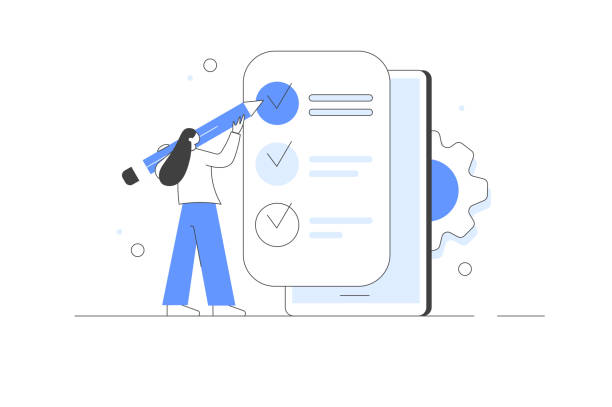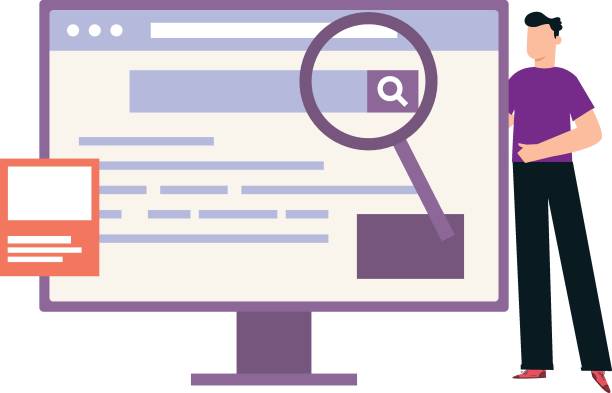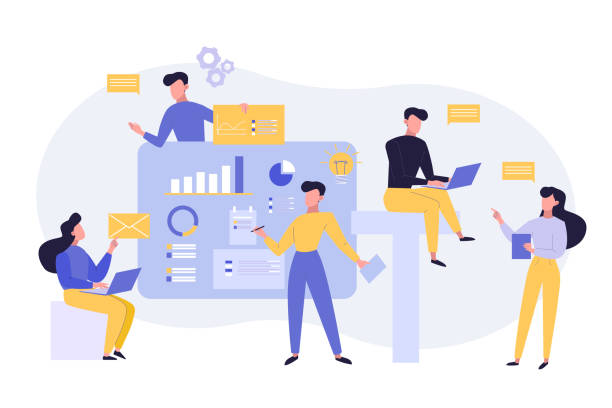Introduction and Importance of Multilingual Website Design

In today’s world, where geographical boundaries have blurred in the digital space, a #multilingual website is no longer merely a competitive advantage; it has become an absolute necessity.
Multilingual website design enables businesses to easily reach a #global audience without language barriers and facilitate the #expansion of their business beyond domestic and regional borders.
This progressive approach not only significantly increases website visitors from various parts of the world but also helps brands establish deeper and more meaningful connections with potential customers across different cultures and languages.
Imagine you offer an innovative product or service with global potential; without a multilingual website, you will practically lose a vast portion of this enormous and growing market and remain limited to your monolingual audience.
The primary goal of such a comprehensive and inclusive design is to present content in a language that the user is most comfortable with and understands best, as language is the first and most crucial bridge to users.
This not only significantly improves user experience (UX) and increases customer satisfaction but also clearly demonstrates your business’s credibility and professionalism on an international scale, building greater trust.
In fact, many reputable studies in e-commerce have shown that users are more inclined and willing to purchase from, interact with, and remain loyal to websites whose content is presented in their native language and with local cultural understanding.
This is not just a simple #explanation; it is a vital strategy.
This concept goes beyond merely literal translation of words; it encompasses a more complex and comprehensive process called Localization, which involves adapting content, observing cultural norms, changing currency units, date and time formats, and even altering the design structure and visual element arrangement to match regional preferences and expectations.
This comprehensive and nuanced approach significantly increases the trust factor of international users and creates a stronger sense of connection with your brand.
Therefore, the #educational nature of this process is of high importance for all individuals involved in the project, and development, marketing, and content teams must proceed with great care and sufficient knowledge through the design and implementation stages.
Its correct and principled implementation requires a deep understanding of #web technologies, information architecture, as well as the principles of #international marketing and localization.
From the correct selection of content management systems (CMS) and translation tools to the implementation of advanced international SEO techniques, every step must be taken with precision, prior planning, and a strategic approach.
Given the growing importance of global markets and increasing competition within them, companies that consider multilingual website design from the outset have taken a significant step towards success and surpassed their competitors.
This investment not only yields significant returns in the short term through increased traffic and sales but also greatly contributes to establishing your brand’s position in global markets and building a powerful identity in the long term.
The question that arises is: Is your business ready to enter and compete in this global arena, and how can you best leverage this immense potential of multilingualism?
Are you losing business opportunities because of an outdated website? With Rasawab, permanently solve the problem of not attracting potential customers through your website!
✅ Attract more high-quality leads
✅ Increase brand credibility in customers’ eyes
⚡ Get free corporate website design consultation
Competitive Advantages of Multilingual Websites

Multilingual website design offers businesses the unique opportunity to gain significant competitive advantages in international markets and surpass their monolingual competitors.
One of the most prominent advantages is broad and boundless access to a wider customer base that was previously unreachable.
When your website is available in multiple languages, you not only become more appealing to local users in each geographical region but also achieve a better ranking in #international SEO results and gain more visibility.
This means a significant increase in organic traffic, reduced reliance on paid advertising, and ultimately, exponential growth in sales and revenue.
Imagine your main competitor only has a monolingual website and their market is limited to a specific region; by providing content in multiple languages, you automatically gain an advantage over them and capture a larger share of new and untapped #markets.
This is a simple yet powerful #analysis of global market dynamics and competition, clearly demonstrating how language can serve as a potent bridge and a strategic tool for penetrating new markets.
Furthermore, a multilingual site significantly improves #user experience (UX).
Users feel more comfortable, confident, and deeply connected to a brand when they can read and interact with content in their native language.
This increased customer satisfaction directly leads to a higher Conversion Rate, reduced Bounce Rate, and greater customer loyalty in the long run.
This approach is particularly vital and indispensable for companies looking to enter emerging markets or whose audiences are in regions with lower English proficiency.
Moreover, multilingual website design helps companies present a global, modern, and responsible image, demonstrating their commitment to the needs and cultural diversity of their customers worldwide.
This positive image not only attracts new customers and adds credibility to your brand but can also draw international business partners and investors towards you, creating new collaboration opportunities.
Finally, data collected from multilingual users provides invaluable and unprecedented insights into consumer preferences, behaviors, and needs across different cultures, which can be highly beneficial and guiding for developing and optimizing future marketing strategies, product development, and business planning.
These multifaceted and strategic advantages clearly underscore the importance of smart investment in a global, multilingual communication platform that can act as a catalyst for your international growth and success.
Technical Challenges and Considerations in Multilingual Website Design

Multilingual website design, while offering numerous competitive advantages, also comes with complex and specific technical challenges that must be addressed with precision and expertise from the initial stages to prevent costly problems in the future.
One of the first and most crucial challenges is choosing and implementing the appropriate #URL structure.
Deciding whether to use subdirectories (e.g., yoursite.com/fa), subdomains (fa.yoursite.com), or separate domains (yoursite.fr) is a key choice.
Each of these methods has its unique advantages and disadvantages, and the correct choice depends on your SEO goals, overall business structure, and marketing strategy.
Another challenge relates to #hosting and server resource management; especially if the volume of content in different languages is very large and you have high traffic, you will need a stronger infrastructure with high scalability and possibly local servers in different regions.
Furthermore, #content management in a multilingual environment can be very complex and time-consuming.
Ensuring that each language version is correctly updated, translations are always synchronized and consistent, and outdated content is removed, requires an efficient content management system (CMS) and an organized and precise translation workflow to prevent confusion for users and search engines.
Additionally, issues related to character encoding (such as using UTF-8 to support various scripts including Persian and Arabic), right-to-left (RTL) text for languages written from right to left, and critical issues related to international SEO, such as the correct implementation of the hreflang tag, are among the #specialized and highly critical challenges.
Ignoring or incorrectly implementing any of these can lead to serious problems in site performance, user experience, and especially its ranking in search engines.
For instance, if hreflang tags are not implemented correctly, Google might consider different language versions as Duplicate Content, severely damaging the site’s overall ranking.
Web development teams and SEO specialists must fully consider these technical considerations from the very beginning of the project to prevent additional costs, complex reworks, and wasted time and resources in the future.
Multilingual website design is a complex and multifaceted process that requires sufficient expertise and experience in various technical, SEO, and digital marketing fields.
This is a major challenge that can be overcome with an engineered approach, precise planning, and team collaboration to achieve success.
Below is a comparative table of common URL structure methods for multilingual websites that can help you choose the best option:
| Method | Example | Advantages | Disadvantages | Recommended Use Cases |
|---|---|---|---|---|
| Subdirectory | example.com/fr/ |
|
|
Best option for most businesses, blogs, and corporate sites with common needs. |
| Subdomain | fr.example.com |
|
|
Large companies needing strong geographical separation, SaaS software, and specialized blogs. |
| Separate Domains (ccTLD) | example.fr |
|
|
Large companies and global brands with a strong and independent presence in specific markets and sufficient budget. |
Choosing the Best Strategy for Multilingual Implementation

After a deep understanding of the technical challenges and related considerations, one of the most important decisions in the path of multilingual website design is choosing the best #strategy for implementing multilingual functionality on the website.
This is a critical #guidance step that will directly impact SEO performance, user experience (UX), and the ease of long-term site management and maintenance.
There are three main and recognized approaches to structuring multilingual websites: using #subdirectories, #subdomains, and #separate domains with country-code top-level domains (ccTLDs).
Each of these options has its specific strengths and weaknesses, and the final choice must be made by carefully considering your business’s commercial objectives, allocated budget, available technical team resources, and international marketing strategy.
Subdirectories, such as `example.com/en/` for the English version or `example.com/es/` for the Spanish version, are usually the simplest and most common method for implementation.
From an SEO perspective, this method best shares the authority and power of the main domain across all language versions, as all languages reside under a single domain.
This structure is ideal for most small and medium-sized businesses looking for a simple, efficient, and cost-effective solution with minimal technical and SEO complexity.
Google and other search engines typically understand this structure well, and its management is relatively easier, as all content is managed under one content management system.
In contrast, subdomains, such as `en.example.com` or `es.example.com`, offer more flexibility in hosting and technical separation.
For example, you can host each subdomain on local servers (target countries) to optimize loading speed for users in that region.
However, from an SEO perspective, Google might view each subdomain as an almost independent entity, meaning more effort is required to build SEO authority for each subdomain separately.
This method is more suitable for companies that require stronger geographical separation, independent management for each language, or local hosting to optimize performance.
Finally, separate domains with country-code top-level domains (ccTLDs), such as `example.co.uk` for the UK or `example.de` for Germany, provide the highest level of credibility, localization, and trust in specific markets.
This method gives users a sense of local presence and is very powerful for local SEO; however, its costs and management complexities are significantly higher, as it requires purchasing and maintaining multiple domains and possibly local marketing and SEO teams for each domain.
Any decision for multilingual website design must be made in close consultation with SEO and web development specialists to ensure the selection of the appropriate strategy for achieving global business objectives, maximizing website potential, and preventing future problems.
Are you frustrated by your e-commerce site’s low conversion rate? Rasawab transforms your e-commerce site into a powerful tool for attracting and converting customers!
✅ Significant increase in visitor-to-buyer conversion rate
✅ Unparalleled user experience to boost customer satisfaction and loyalty⚡ Get free consultation from Rasawab!
Importance of Content Translation and Cultural Localization

One of the most crucial pillars in the success of multilingual website design, beyond purely technical aspects, is accurate and comprehensive #translation and deep #cultural localization of content.
Merely literal translation of words from one language to another is never sufficient and cannot yield desired results; instead, it must be ensured that the brand’s core message, content tone, writing style, and even cultural references and idioms are completely understandable, relevant, and appropriate for local audiences.
This process is a vital and essential #educational component for any team intending to seriously and effectively enter international markets and connect with global audiences.
For example, a colloquialism, a local joke, or even a reference to historical events that is very popular and understandable in one culture, might be considered completely meaningless, incomprehensible, or even offensive in another culture.
Therefore, Localization, beyond translation, involves the complete adaptation of content to the customs, values, beliefs, and cultural expectations of each specific region.
This includes not only textual content but also the correct selection and use of images, videos, currency units, date and time formats, phone numbers, addresses, and even colors and symbols; because each of these elements can have different meanings and interpretations in various cultures.
To ensure high-quality translation and effective localization, it is strongly recommended to use professional native-speaking translators specialized in your website’s subject matter.
These translators not only have full command of the target language but are also completely familiar with cultural nuances, common idioms, and regional sensitivities.
Machine translation, although it has made significant progress in recent years and can be useful for quickly translating large volumes of text, is still unable to fully grasp cultural nuances, maintain a brand’s specific tone, and convey hidden emotions in the text.
A poor translation or incomplete localization can severely damage your brand’s credibility, present an unprofessional image of you, and even cause local audiences to deem your site untrustworthy or irrelevant.
Therefore, investing in professional and high-quality translation and localization is a vital and profitable investment for success in global markets and should not be viewed as an expense.
This process should also include meticulous and continuous review of content and receiving feedback from local users to ensure the accuracy, precision, and appropriateness of the content for the target culture, enabling continuous improvement.
Remember that the ultimate goal of multilingual website design is to create a seamless, comfortable, and highly personalized user experience for all visitors, regardless of their language or culture.
This effort to understand and respect cultural differences can lead to stronger, more sustainable, and more beneficial relationships with global customers and ensure long-term loyalty.
Search Engine Optimization (SEO) for Multilingual Websites

Search Engine Optimization (SEO) for a multilingual site has specific and unique complexities that require a #specialized and very precise approach.
In this approach, merely translating keywords from one language to another is by no means sufficient; instead, #local and high-volume keywords for each language and target market must be identified and utilized separately.
This means conducting extensive and independent keyword research for each language and region you intend to target, taking into account cultural and dialectical differences.
One of the most important and critical aspects of multilingual SEO is the correct and precise use of the #hreflang tag.
This tag informs search engines like Google and Bing that different pages of your site are alternative versions of each other (in terms of language or geographical region), thereby preventing duplicate content.
Incorrect or incomplete implementation of hreflang can lead to serious problems such as Duplicate Content, which severely damages your site’s ranking in search results and results in lost organic traffic.
In addition to correct hreflang implementation, creating a separate and dedicated #XML sitemap for each language and submitting it to Google Webmaster Tools (Google Search Console) and Bing Webmaster Tools is also strongly recommended.
This helps search engines quickly and fully discover and index all language versions of your site, ensuring no page is overlooked.
Furthermore, special attention must be paid to page loading speed in different parts of the world.
Using Content Delivery Networks (CDNs), which store your site’s content on servers close to users worldwide, can significantly improve loading speeds for international users and optimize user experience.
Internal and external linking should also be done intelligently and with consideration for the site’s multilingual structure; meaning links should point to the correct language pages, and broken or incorrect links should be avoided.
For example, an internal link from a Persian page should point to another Persian page, not its English version.
Finally, continuous and precise monitoring of SEO performance in each language and region, through advanced web analytics tools, is crucial.
This enables you to identify and resolve any potential issues in ranking, traffic, or indexing, and continuously improve your SEO strategy to align with changes in search algorithms and market needs.
Multilingual website design, by considering all these advanced SEO principles and tips, can ensure that your valuable content reaches target audiences worldwide and maximizes your business potential.
This complex yet valuable effort is key to success in the global competitive arena and can make a significant difference in your online visibility and growth.
Popular Tools and Platforms for Multilingual Website Design

To facilitate the complex process of multilingual website design, various software tools and platforms are now available to developers and business owners, each with its own features, capabilities, and advantages.
The choice of the right tool depends on the type of website desired, the allocated budget, and the technical expertise level of your team.
In this section, we introduce some of the most popular and efficient options that can greatly assist you in building an effective, efficient, and manageable multilingual website.
One of the most common and popular approaches is using well-known Content Management Systems (CMS) like WordPress, which, with the help of powerful and specialized #WordPress plugins, offer integrated multilingual capabilities.
Plugins like WPML (WordPress Multilingual Plugin) and Polylang are among the most popular and comprehensive options in this area, providing the ability to translate almost all site elements, including posts, pages, categories, tags, menus, widgets, and even theme and plugin strings.
These plugins facilitate the translation and management of multilingual content for site administrators by offering dedicated user panels.
In addition to WordPress, other platforms also natively support multilingualism or provide powerful built-in tools for developers for this purpose.
For example, Drupal, due to its strong and modular architecture, has been designed from the outset with advanced multilingual capabilities and is considered a very powerful option for large, complex, and high-security websites.
Drupal natively provides precise management of translations, regional settings, and multilingual URL paths.
For developers seeking more control and maximum flexibility, frameworks like Laravel for PHP or Django for Python, along with translation libraries (such as Laravel Localization or Django i18n), allow for building #custom CMS with complete multilingual support.
This approach is suitable for projects with specific and unique requirements.
Finally, the importance of cloud-based #translation tools and Translation Management Systems (TMS) such as Smartling, Phrase, Trados, or OneSky should not be overlooked.
These advanced platforms can automatically and systematically manage the translation and localization process, create Translation Memory and Glossary, and enable effective collaboration among translators, editors, and project managers.
Using these TMSs significantly improves translation quality, consistency, and speed, especially for projects with a very large volume of content and a need for continuous translation.
A smart and strategic choice among these tools can transform the complex process of multilingual website design into a simpler, more efficient, and ultimately more successful experience.
Below is a comparative table of popular tools:
| Tool/Platform Name | Type | Advantages | Disadvantages | Suitable For |
|---|---|---|---|---|
| WPML (WordPress) | CMS Plugin |
|
|
Blogs, small and medium corporate websites, and WordPress-based online stores. |
| Polylang (WordPress) | CMS Plugin |
|
|
Simpler WordPress blogs and websites with limited budgets and fewer needs. |
| Drupal | Full CMS |
|
|
Government websites, universities, large portals, and companies with complex needs and high scalability. |
| Smartling / Phrase | Translation Management System (TMS) |
|
|
Large companies with a high volume of multilingual content and a need for continuous and fast translation and updates. |
Maintenance and Updates for Multilingual Websites

After the successful completion of the multilingual website design process and its launch online, the work is by no means finished.
In fact, the critical stage of continuous #maintenance and #updating is as important and prioritized as the initial design and development process itself.
An active and dynamic multilingual site requires continuous and planned care to ensure proper functioning and to provide a flawless and optimal experience for users worldwide.
This #guidance process includes several important and key aspects that must be periodically and regularly reviewed, revised, and optimized to maintain the site’s efficiency and effectiveness.
The first and perhaps most important aspect is #content updating.
Whenever new content is added to the original language (source language) or existing content is changed and requires revision, it must be ensured that these changes are quickly, accurately, and completely translated and published across all language versions.
Content inconsistencies between different language versions can lead to user confusion, provide inaccurate information, and ultimately severely damage your brand’s credibility and image.
The next and very important aspect is #technical support and precise monitoring of site performance.
Technical problems such as Broken Links, slow loading speeds in a specific geographical region, incompatibility with various web browsers or mobile devices, and server errors must be quickly identified and resolved.
This includes continuous monitoring of server health, website security against cyber-attacks, and continuous updating of Content Management Systems (CMS) and all plugins or modules used to prevent vulnerabilities.
Furthermore, precise monitoring of SEO performance in each language and geographical region is of high importance.
Tracking keyword rankings, organic traffic volume, bounce rate, and conversion rate for each language helps you identify potential problems in each target market and continuously adjust and optimize your SEO and marketing strategies.
Receiving direct feedback from local users and examining reported issues can provide valuable insights for continuous improvement of user experience and content.
Neglecting regular maintenance and updates can, over time, lead to a severe decline in the quality, efficiency, and ranking of a multilingual site, thereby rendering the initial investment in multilingual website design ineffective.
Therefore, allocating sufficient resources, both human and financial, is crucial for this vital stage to ensure that your website remains a powerful, effective, and competitive communication platform in the global arena and continuously contributes to your business objectives.
Are you tired of your e-commerce site having visitors but no sales? Rasawab solves your main problem with professional e-commerce website design!
✅ Significant sales increase with targeted design
✅ Seamless user experience for your customers
⚡ Get a free consultation!
The Future of Web Design and Digital Multilingualism

The future of multilingual website design is intertwined with rapid and continuous advancements in technology, especially in the fields of #Artificial Intelligence (AI) and #Machine Translation.
These exciting #news developments have the potential to completely transform how multilingual sites are created, managed, and interacted with, pushing current boundaries.
Although machine translation has not yet reached the level of accuracy and nuance of human translation, with advanced tools like Google Translate, DeepL, and Neural Machine Translation systems, its accuracy and fluency have significantly improved.
It is expected that in the near future, with more advanced AI, these tools will be able to better understand cultural nuances, maintain precise brand tone, and convey hidden emotions in text, playing a much larger role in the translation and localization process.
This can significantly reduce the time and cost required for producing and updating multilingual content, making the process more cost-effective for businesses.
In addition to translation, AI can also play a key role in dynamic content localization.
Through extensive analysis of user data, behavioral patterns, and regional preferences, AI can automatically suggest adaptations for images, videos, colors, and even the structure and layout of web pages for specific markets and local users.
This advanced #analytical approach allows websites to dynamically personalize content based on geographical location, language, and even users’ personal profiles, providing a completely unique and relevant experience.
The emergence of nascent technologies such as Web3, Virtual Reality (VR), and the Metaverse can also profoundly impact the future of digital multilingualism.
In virtual and immersive spaces, the need for multilingual communications will be felt even more strongly than before, potentially leading to the development of entirely new user interfaces for real-time conversation translation, automatic adaptation of virtual environment languages, and real-time multilingual interactions.
Furthermore, the explosive growth of #emerging markets in Asia, Africa, and Latin America and increased internet access in various parts of the world will further boost demand for multilingual content, creating new opportunities for businesses ready to go global.
Businesses that invest in multilingual website design now and are prepared to embrace future technologies and rapid changes in the digital world will be in a better position to fully leverage these global opportunities and can become pioneers in the international arena.
Frequently Asked Questions in Multilingual Website Design

Multilingual website design is always accompanied by numerous questions and ambiguities that can be confusing for business owners or web developers.
In this section, we provide comprehensive answers and necessary #guidance to some of the #frequently asked questions and common concerns that may arise during the planning, design, and implementation process of a multilingual website, to clarify existing ambiguities and enable you to make more informed decisions.
This is a thought-provoking #question-based content that aims to cover the most frequently occurring issues.
1.
Is multilingual website design expensive, and how can costs be managed?
The cost of designing and implementing a multilingual website can vary significantly and depends on multiple factors, including the number of languages you intend to support, the overall volume of site content, the technical complexity and required customizations, and the content translation method (using professional human translators versus machine translation).
While the initial investment for a multilingual site might be higher than for a monolingual site, the return on investment (ROI) through access to new markets, a significant increase in the international customer base, and improved brand image can be very impressive and profitable in the long term.
To manage costs, using existing plugins for Content Management Systems (CMS) like WordPress (WPML or Polylang) typically offers more cost-effective solutions that are suitable for many businesses.
Furthermore, you can manage costs in different phases by prioritizing languages and starting with those that have the greatest market potential.
2.
What is the best time to make a site multilingual? Can an existing site be made multilingual?
The best and most ideal time to plan and implement multilingual functionality is from the very beginning, i.e., in the initial website planning and design phase.
This approach allows for the creation of an optimal information architecture and technical structure from the outset.
Adding multilingual functionality to an existing and pre-designed site can be more complex and costly; as it may require rebuilding the URL structure, re-evaluating the database, migrating and translating a large volume of existing content, and making extensive modifications to the site’s code and template.
However, if you intend to expand into global markets and previously had a monolingual site, it’s never too late to start, and with careful planning and the use of appropriate tools, this process can be successfully completed.
3.
Is machine translation sufficient for the main and important content of a multilingual site?
No, machine translation alone is not recommended for core, important, and critical site content such as product descriptions, service pages, legal information, or marketing content.
Although machine translation tools like Google Translate and DeepL have made significant progress and can be useful for a general understanding of text, they are still unable to fully grasp cultural nuances, specific idioms, connotations, and brand tone.
For critical content that directly impacts brand image, credibility, and customer decision-making, the use of professional native-speaking and specialized translators is essential.
Machine translation can be used for less critical content, user-generated content (UGC), or as a starting point for human translation (which is then reviewed and edited by a human translator) to increase work speed.
4.
How can I ensure my multilingual site is optimized for SEO?
To ensure multilingual SEO optimization, you need to follow several key steps.
Firstly, use hreflang tags correctly and without errors so that search engines properly identify the different language versions of your site.
Secondly, conduct thorough and comprehensive keyword research for each language and target market, and use relevant local keywords.
Thirdly, choose an appropriate URL structure (subdirectory, subdomain, or ccTLD) that is optimized for international SEO.
Fourthly, create separate XML Sitemaps for each language and register them in webmaster tools.
Also, pay attention to site loading speed in different regions of the world (by using a CDN) and provide a localized and smooth user experience.
Finally, continuous monitoring of SEO performance with analytical and webmaster tools is essential.
These are just some of the frequently asked questions in the field of multilingual website design, and each project can have its unique challenges.
Consulting with specialists in this field can greatly assist you in making correct decisions, avoiding common mistakes, and achieving success in global markets.
Frequently Asked Questions
| Number | Question | Answer |
|---|---|---|
| 1 | What is multilingual website design? | Multilingual website design refers to creating a website whose content is available to users in several different languages. This is usually done through a simple user interface for changing the language. |
| 2 | Why should we design a multilingual website? | Multilingual website design helps you reach a wider audience worldwide, provide a better user experience for international users, and improve your global SEO. |
| 3 | What are the main methods for implementing multilingualism on a website? | The main methods include using subdomains, subdirectories, or URL parameters for each language, and also using entirely separate domains for each language. |
| 4 | Is using a subdirectory or subdomain better for SEO? | From an SEO perspective, both subdirectory and subdomain methods can be effective. However, many SEO specialists prefer subdirectories due to better transfer of main domain authority. |
| 5 | What are the important points in translating multilingual website content? | Translation should be done by native translators, content should be localized (localization) in addition to translation to match the target audience’s culture, and pure machine translation should be avoided. |
| 6 | What is the role of the hreflang tag in multilingual site SEO? | The hreflang tag helps search engines like Google display the correct language and regional version of a page to appropriate users, which also prevents duplicate content issues. |
| 7 | Can a website be made multilingual without coding? | Yes, in Content Management Systems (CMS) like WordPress, powerful plugins such as WPML or Polylang exist that allow you to make a website multilingual without needing to code. |
| 8 | What are the challenges of multilingual website design? | Challenges include translation management, content localization, adhering to SEO principles for each language, technical support for different languages, and ensuring design consistency across different languages. |
| 9 | What is the difference between translation and localization? | Translation is merely converting words from one language to another, while localization involves adapting content to the culture, customs, currency, date and time formats, and even appropriate colors for the target audience. |
| 10 | What is the best user experience (UX) for language switching? | A clear and accessible language switcher (usually in the header or footer), using the language name instead of flags (due to regional diversity), and maintaining the user’s position after changing the language are important UX considerations. |
And other advertising services of Rasawab Advertising Agency
Smart Marketing Automation: An innovative service for increasing customer behavior analysis through user experience customization.
Smart Customer Journey Map: An innovative service for increasing click-through rates through attractive user interface design.
Smart SEO: Revolutionize online growth with Google Ads management.
Smart Conversion Rate Optimization: Designed for businesses seeking online growth through the use of real data.
Smart Marketing Automation: A dedicated service for increasing website traffic growth based on intelligent data analysis.
And over a hundred other services in internet advertising, advertising consultation, and organizational solutions
Internet Advertising | Advertising Strategy | Sponsored Articles
Resources
Multilingual Website Design and SEO
Advantages of Multilingual Websites for Businesses
How to Implement a Multilingual Site
The Future of E-commerce and Languages
? Are you ready to revolutionize your business in the digital world? Rasawab Afarin, a leading digital marketing agency, paves your path to growth by offering comprehensive services including custom website design, SEO, and advertising campaign management.
📍 Tehran, Mirdamad Street, Next to Central Bank, Kazeroun South Alley, Ramin Alley No. 6



